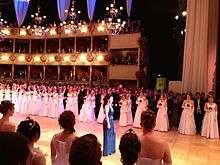Vienna Opera Ball



The Vienna Opera Ball (German: Wiener Opernball) is an annual Austrian society event which takes place in the building of the Vienna State Opera in Vienna, Austria on the Thursday preceding Ash Wednesday (a religious holiday). Together with the New Year Concert, the Opera Ball is one of the highlights of the Viennese carnival season.
History
The tradition of the ball goes back to 1814 during the time of the Vienna Congress, where the crowned heads of Europe and the aristocracy searched for entertainment after the Napoleonic wars. The first ball in the opera house took place in 1877 as a soirée. The following balls were redoute, a French term for masquerade balls or costume parties, where the ladies wore theirs masks until midnight. Starting in 1878 until 1899, such redoute balls took place around two to three times a year.
The first redoute after World War I took place in 1921, with proceeds going to the pension fund of the two state theatres. These events were called also called Opernredoute.
The first ball to be named "Opera Ball" was first held in 1935 under the honorary patronage of the Federal Chancellor, but was suspended during World War II. It was revived after the war; it has been held annually ever since, with the exception of 1991, when it was cancelled due to the Persian Gulf War. Since 2008, Desirée Treichl-Stürgkh has been the chairman (supervising organizer) of the Vienna Opera Ball. The ball is the highlight of the season, with the heads of state and government, the political and industrial elite, members of the high society, and their guests attending. The price for the entry tickets is the highest of all the Viennese balls.
Starting in 1987, the Opernballdemo, a left-wing demonstration along the Ringstraße against the kind of capitalism represented by, as the protesters see it, many of the elite attending the ball, has regularly taken place on the same night. There have been occasional outbreaks of violence. This has almost disappeared since 2011, with protests focusing on the nationalist Akademikerball instead.
The only ball officially associated with the Vienna Opera Ball is the Dubai Opera Ball. A similar ball takes place in New York City and another in Budapest, but they are not affiliated with the Vienna Opera Ball.
Organization
Each year, almost overnight, the auditorium of the Vienna State Opera is turned into a large ballroom. On the eve of the event, the rows of seats are removed from the stalls, and a new floor, level with the stage, is built.
The dress code is evening dress: white tie and tails for men; usually floor-length gowns for women.
The ball does not start until around 10 pm when the Austrian president and his guests enter the imperial balcony. The arrival is heralded by trumpets. The Austrian national anthem is played followed by the European anthem. There are performances of the state opera ballet company and classical arias sung by the opera stars. These are normally a small selection of Italian opera and famous Austrian pieces. The highlight of the opening ceremony is the introduction of 180 debutante couples. These are carefully selected young women and men, who had to successfully complete an application program and a strict classical dance choreography organised by the Elmayer dance school. The debutantes are led into the opera house to the sounds of Carl Michael Ziehrer's Fächerpolonaise. Dances are then for example the Polonaise in A-Dur, Op. 40 by Frédéric Chopin and Johann Strauss' Warschauer-Polka. The last dance of the debutantes is always the Blue Danube Viennese Waltz by Johann Strauss II, after which the floor is opened to all guests.
The ball runs until 6 am in the morning. The opera house offers all access to the guests, with various other rooms and lounges open with different types of music and dance. There is catering on all floors offered by Café Gerstner, also a hairdresser, an in-house tailor, and medical teams on standby. Casinos Austria is one of the sponsors and offers roulette.
Various dances moderated by the master of ceremony take place every two hours, such as the popular cotillion. Although not officially allowed, towards the end the tradition is for the guests to take apart the flower decoration on the balcony and shower the remaining dancers with it on the main floor, or take it home.
In a joint venture, ORF and BR broadcast live from the ball for several hours each year.
In media
In 1995 Austrian writer Josef Haslinger published a novel entitled Opernball in which thousands of people are killed in a Neo-Nazi terrorist attack taking place during that society event. The novel was the basis of a 1998 made-for-TV movie by Urs Egger with the same title.
The ball was featured in the postcard for San Marino in the Eurovision Song Contest 2015. In it, San Marinese participants Michele Perniola and Anita Simoncini attend an evening at the ball.
See also
External links
| Wikimedia Commons has media related to Vienna Opera Ball. |
- Viennese Opera Ball Vienna - Opernball Thursday before Ash Wednesday February 19, 2009
- Information on the Vienna Opera Ball with Video
- Viennese Opera Ball New York - Friday February 6, 2009
- Viennese Opera Ball Dubai - Thursday March 16, 2006
- Viennese Opera Ball Hong Kong - Saturday September 27, 2008
- Study about the Vienna Opera Ball by the Humaninstitut